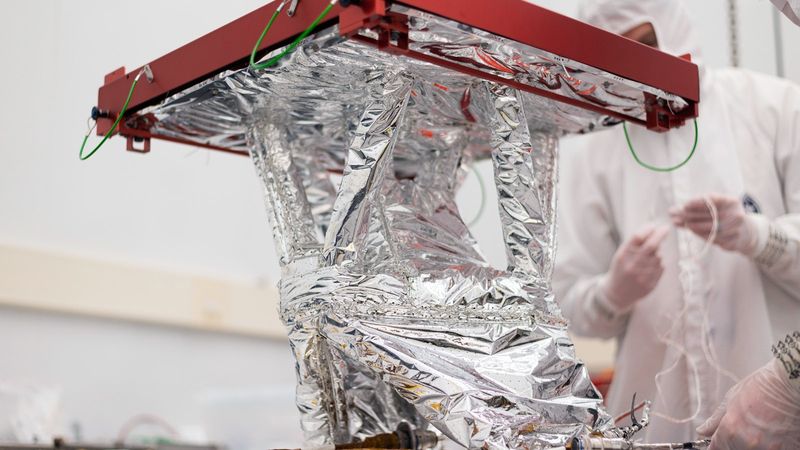
In this March 3 photo, Space Dynamics Laboratory engineers prepare the Mapping Imaging Spectrometer for Europa instrument Radiator Cryocooler Mount Assembly for NASA's Europa Clipper mission for shipment from SDL to NASA’s Jet Propulsion Laboratory. The MISE RCM is a thermal management system that will be integrated on Europa Clipper—a spacecraft that will determine the habitability of Jupiter’s Galilean moon Europa. (Credit: Allison Bills/Space Dynamics Laboratory).
Utah State University’s Space Dynamics Laboratory announced today that it has delivered a crucial subsystem to support NASA’s interplanetary mission to determine the habitability of Jupiter’s Galilean moon Europa. NASA’s Jet Propulsion Laboratory manages the mission, called Europa Clipper.
The search for life beyond our home planet—it’s one of NASA’s primary ambitions because to understand humanity’s place in the universe, we must discover if Earth is the only place where life exists.
The Europa Clipper spacecraft is planned for launch in 2024 and will conduct a detailed survey of Jupiter’s moon Europa to determine whether the moon could harbor conditions suitable for life. Among the science instruments Europa Clipper will host to investigate the icy moon is the Mapping Imaging Spectrometer for Europa instrument, or MISE. SDL designed, built, tested, and delivered a major component of MISE’s thermal management system, which provides the cooling source for the instrument and its detector and rejects the waste heat into space.
The MISE instrument will map Europa’s distribution of ices, salts, organics, and warmest hotspots by imaging reflected infrared light and separating it into its various wavelengths. These maps will help determine if the moon’s suspected ocean is an environment suitable for life and will help reveal Europa’s geologic history. The SDL-built Radiator Cryocooler Mount Assembly will transfer heat away from MISE, allowing the instrument’s detector and spectrometer to reach a temperature of nearly 80 Kelvin—approximately negative 315 degrees Fahrenheit. Additionally, the cryocooler is equipped with heaters and temperature sensors to protect the cryocooler and radiator from getting too cold.
The MISE infrared detector and other optical components must be cooled to 80 degrees Kelvin to ensure their thermal emissions will not interfere with spectral emissions from Europa. If the instrument is too warm, the emitted energy can interfere with Europa’s spectral radiation, which it is designed to measure.
“Because MISE will image Europa in the infrared wavelength, it’s critical that the instrument remains cooler than the moon’s surface materials. To accomplish this, SDL provided the Radiator Cryocooler Mount Assembly, which incorporates space-proven technologies such as a radiator, cryocooler, thermal straps, heaters, and temperature sensors—all integrated into a structure that can survive launch vibrations and Europa’s harsh radiation environment,” said Curtis Bingham, SDL’s program manager for the project. “It has been an honor for SDL to work under JPL’s leadership and contribute to a mission that will help determine if Europa contains the essential ingredients for life.”
Among the chief elements that make life possible is water. Water provides the dissolved nutrients for organisms to consume, carries essential chemicals within living cells, and allows cells to eliminate waste products. Studies of Europa suggest that the moon could have more water than Earth in the form of a salty ocean below its crust. Scientists have theorized that other building blocks of life were present on Europa as it formed, and as asteroids and comets collided with the moon, they could have left more organic materials.
“One of SDL’s core competencies is thermal and structural management to mitigate risks for spacecraft electronics and instrument systems that are susceptible to stresses during launch and while operating in the severe space environment. We are privileged to provide NASA with a key component of the thermal management system for the MISE science instrument,” said Alan Thurgood, SDL’s director of civil and commercial space. “The delivery of the Radiator Cryocooler Mount Assembly represents a continued collaboration between NASA and SDL on extraordinary and storied missions.”
SDL has been solving the technical challenges faced by the military, science community, and industry for six decades and supports NASA’s mission to drive advances in science, technology, aeronautics, and space exploration to enhance knowledge, education, innovation, economic vitality, and stewardship of Earth. As one of 14 University Affiliated Research Centers, SDL serves as a subject matter expert in its core research areas to the U.S. Government, ensuring that essential engineering and technology capabilities are maintained. SDL is a research laboratory headquartered in North Logan, UT, and has offices in Albuquerque, NM; Bedford, MA; Colorado Springs, CO; Dayton, OH; Huntsville, AL; Houston, TX; Los Angeles, CA; Stafford, VA; and Washington, DC. For more information, visit www.sdl.usu.edu.
Contact
- SDL Public Relations
- (435) 713-3054
- pr@sdl.usu.edu